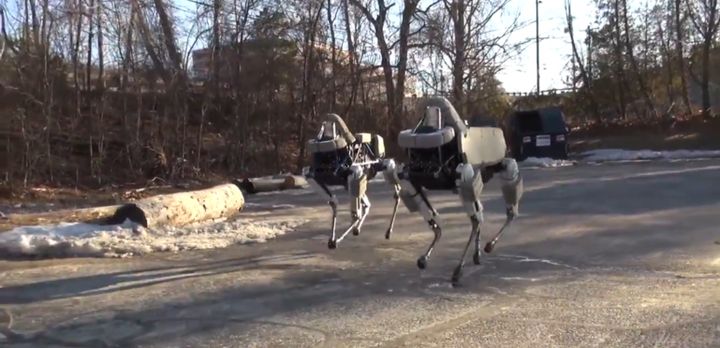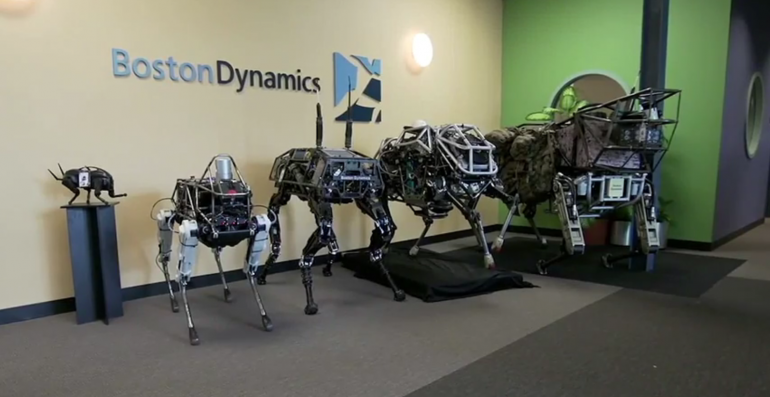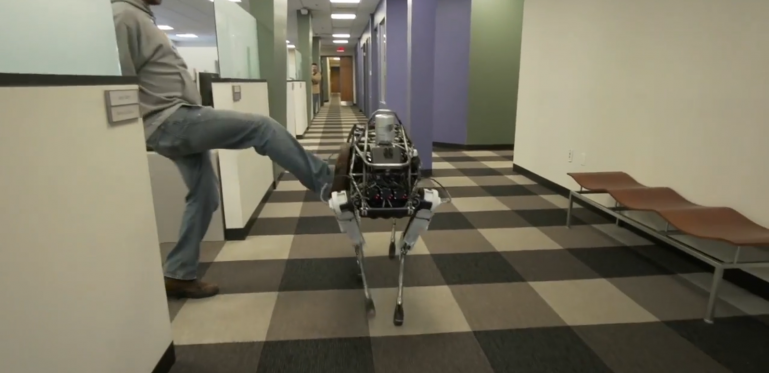
You may recall how in the past few years, the robotics company Boston Dynamics has been the focus of so much attention. Between Cheetah, the Legged Squad Support System (LS3), Atlas, Big Dog, Little Dog, Sand Flea, RiSe and Petman, they have pretty much written the book on modern animatronic and anthropomorphic robots.
Little wonder why Google choose to acquire them back in December of 2013. And it seems they are at it again!
Meet Spot, the latest incarnation of the company's line of animatronic robots. Similar in design to Big Dog, which debuted back in 2005, Spot is essentially a smaller, nimbler version with improved balance. Weighing in at 72.5 kg (160 lb), this electrically-powered, hydraulically-actuated, four-legged robot made its debut in a YouTube video released by the company back in February.
In the video, Spot is seen easily navigating office corridors with a certain equine-like grace, climbing up concrete stairs, and across rocky terrain without any difficulty. At one point, one of the office workers even delivers a kick, which Spot absorbs without losing its footing. Much the same is observed later when two Spot robots are trekking up a hill, repeatedly collide into each other, and correct for the impacts.
The Spot robot (far left), standing next to other four-legged designs by Boston Dynamics. Credit: Boston Dynamics.
Eventually, they straighten out, climb in tandem to the top of the hill, and then turn towards each other. All of this showcases Spot's ability to navigate different environments and terrain, maintain its balance while subject to interferance, and perhaps even function in accordance with some hive-mind algorithms that allow different units to work together.
This is all in keeping with BD's reputation for biologically-inspired robots that mimic the motion and behavior of real life forms. But unlike the company's larger robots, Spot runs on an electrical/hydraulic system that appears to be powered solely by electronic power cells, and not an internal combustion engine (like the LS3 and Big Dog). This also makes Spot much quieter than its predecessors.
Another improvement is the configuration of the legs, which is where its improved agility really comes into play. Whereas Big Dog and other canine robots use a forward-angled leg design, Spot's legs are angled backwards like those of a goat, which allows for a light-footed gate and much surer footing. The company's robots are well known their balance, but Spot manages to self-correct when it is kicked with nothing more than a quick, lifelike stagger.
The Spot robot taking a kick to the side and recovering its balance. Credit: Boston Dynamics
While few details are known about Spot beyond its basic configuration and power/actuator system, other information has been inferred from the video. For instance, Spot appears to be relying on some sort of scanning LIDAR system fitted on its head for navigating, similar to what Big Dog uses. Given its ability to navigate rough terrain and remain stable, it's also safe to assume that it uses the same type of locomotion sensors and gyroscopic stabilizers.
The biggest question though is, what is this robot intended purpose? Whereas the other quadraped robots like Big Dog, Little Dog and the LS3 were clearly intended to act as "pack mules" - assisting troops by carrying their equipment pver rough terrain - Spot's raison d'etre is clearly different. Smaller and nimbler than its predecessors, it seems ideally suited to scouting and surveying missions rather than heavy lifting.
But then again, it might be too soon to assume that Spot is intended for military use at all. Perhaps it is a commercial application, something designed to carry our hand bags and groceries when we're feeling too heavily laiden. Or perhaps Spot could be some form of high-tech seeing eye dog, using algorithms and sensors to assist the blind rather than canine-instincts and training.
Only time will tell. In the meantime, be sure to check out this impressive (and perhaps scary) video of Spot in action:
Top image: Boston Dynamics
Sources:
- www.bostondynamics.com/index.html
- www.gizmag.com/boston-dynamics-spot/36005/
- www.engadget.com/2015/02/10/boston-dynamics-spot-kick-the-dog/
- www.livescience.com/49760-robot-dog-boston-dynamics.html
- www.wired.com/2015/02/creepy-collective-behavior-boston-dynamics-new-robot-dog/
- www.iflscience.com/technology/meet-spot-newest-dog-robot-boston-dynamics










